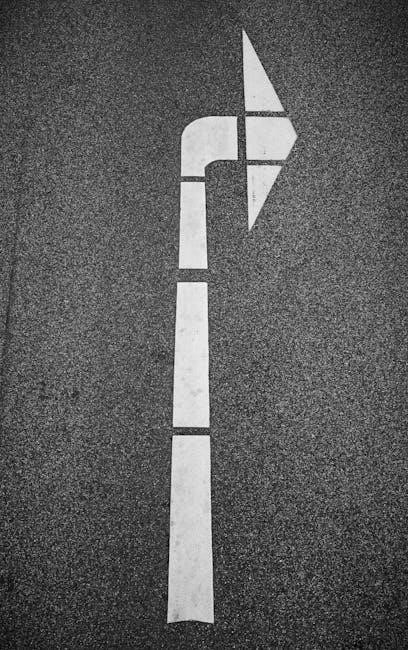Understanding arrow components‚ from length and spine to materials and maintenance‚ is crucial for optimal performance. This guide helps archers select‚ set up‚ and customize arrows for accuracy and consistency in every shot.

Understanding Arrow Components
Arrow components like length‚ spine‚ materials‚ nocks‚ and fletching are essential for accuracy. Proper spine alignment ensures optimal performance‚ while materials vary from fiberglass to carbon fiber‚ each offering unique benefits for different archery disciplines.
1.1 Arrow Length and Draw Length
The correct arrow length is determined by measuring your draw length and ensuring the arrow is long enough to safely clear the bow’s rest or shelf when fully drawn. For recurve bows‚ it’s recommended to add 1-2 inches to your draw length to avoid the arrow falling off the rest. Using an extra-long “draw check” arrow can help archers accurately measure their draw length. Proper arrow length ensures consistent performance and safety‚ preventing accidents during shooting. Arrows that are too short can lead to inconsistent grouping and potential damage to the bow or injury to the archer. Selection charts‚ such as those provided by manufacturers like Beeman‚ can help determine the ideal arrow length based on your bow type and draw weight; Additionally‚ online tools like Archers Advantage offer personalized recommendations for optimal arrow setup. Always ensure your arrows are at least 1-2 inches longer than your draw length for precise alignment and reliable performance.
1.2 Arrow Spine: A Critical Parameter
Arrow spine refers to the arrow’s stiffness and flexibility‚ which significantly impacts accuracy and performance. Proper spine ensures the arrow flies straight and maintains consistent grouping. Incorrect spine can lead to poor accuracy and inconsistent shots. For recurve bows‚ adding 1-2 inches to your draw length helps determine the ideal arrow length. Using tools like Archers Advantage or manufacturer-provided spine charts can help you find the correct spine for your bow specs. Arrows with the wrong spine may wobble in flight‚ reducing precision. Matching the spine to your bow’s specifications is crucial for optimal performance. Regularly checking and adjusting your arrows’ spine ensures consistent results. By understanding and selecting the right spine‚ archers can enhance their shooting accuracy and overall performance.
1.3 Arrow Materials: Fiberglass‚ Carbon Fiber‚ Aluminum‚ Wood‚ and Composites
Arrow materials play a significant role in performance‚ durability‚ and suitability for different archery disciplines. Fiberglass arrows are durable and resistant to splintering‚ making them ideal for beginners and practice. Carbon fiber arrows are lightweight‚ rigid‚ and offer excellent flight consistency‚ favored by competitive archers. Aluminum arrows are traditional‚ offering precise weight distribution and a classic feel. Wood arrows provide a timeless aesthetic and natural appeal‚ though they require more maintenance. Composite arrows blend materials like carbon and aluminum for a balance of strength and flexibility. Choosing the right material depends on your archery style‚ bow type‚ and personal preference. Each material has unique benefits‚ and understanding these differences helps archers select arrows that enhance their shooting experience. By matching arrow materials to their needs‚ archers can achieve better accuracy and overall performance.
1.4 Fletching: Types and Importance
Fletching‚ the feathers or vanes attached to an arrow‚ plays a crucial role in stabilizing its flight. There are two main types: feather fletching and plastic vanes. Feather fletching is traditional‚ lightweight‚ and quieter‚ making it ideal for hunting and traditional archery. Plastic vanes are more durable‚ weather-resistant‚ and easier to maintain‚ often preferred for target shooting and competitive archery. Hybrid fletching combines feathers and vanes for a balance of performance and aesthetics. Fletching size and configuration also matter; larger fletching provides greater stability‚ while smaller designs reduce wind resistance. Proper alignment and symmetry of fletching are essential for consistent accuracy. The number of fletches‚ typically 3-5‚ depends on the arrow’s design and intended use. Fletching preseasoned or fletched at a slight offset enhances arrow rotation‚ improving flight dynamics. Maintaining fletching condition is vital; damaged vanes or feathers can disrupt arrow flight. Understanding fletching types and their purposes helps archers optimize arrow performance for their specific needs.
1.5 Nocks: Design and Functionality
Nocks are the small notched tips at the rear of an arrow‚ designed to securely hold the arrow in place on the bowstring. Their design and functionality are critical for consistent and accurate shooting. There are several types of nocks‚ including captive nocks‚ press-fit nocks‚ and glued-on nocks‚ each with specific applications. Captive nocks are popular for their durability and ease of use‚ while press-fit nocks are commonly used in carbon fiber arrows. Glued-on nocks are traditional and offer a secure fit but require precise installation. The nock’s material‚ such as plastic‚ aluminum‚ or carbon fiber‚ affects its durability and performance. Proper nock alignment and seating on the bowstring are essential for consistent arrow release. The nock’s functionality also includes ensuring the arrow is properly indexed and aligned with the bow. Maintaining the nock’s condition is vital‚ as damaged or worn-out nocks can lead to inconsistent performance and safety issues during shooting.

Choosing the Right Arrow for Your Needs
Selecting the right arrow involves considering arrow length‚ draw length‚ spine‚ and material. Proper fit ensures optimal performance and accuracy‚ while matching arrows to your bow and archery style enhances shooting efficiency and precision.
2.1 Arrow Selection Based on Archery Discipline
Arrow selection varies significantly based on the archery discipline. For target archery‚ precision and consistency are paramount‚ requiring arrows with tight weight and spine tolerances. Hunting arrows must be durable and designed for kinetic energy transfer‚ often featuring broadheads. Recreational archery prioritizes versatility‚ with arrows that balance performance and affordability. Competitive archers may opt for high-end materials like carbon fiber for optimal speed and accuracy. Traditional archery often favors natural materials such as wood or bamboo‚ emphasizing historical authenticity. Each discipline demands specific arrow characteristics to meet performance and practical needs‚ ensuring optimal results in varied shooting scenarios. Understanding these differences is crucial for selecting arrows that align with your archery goals and style.

2.2 Using Arrow Selection Charts for Optimal Fit
Arrow selection charts are invaluable tools for determining the most suitable arrows for your specific needs. These charts typically incorporate factors such as bow weight‚ draw length‚ and arrow length to recommend appropriate arrow specifications. By inputting your bow’s specifications and personal shooting style‚ the chart generates a tailored suggestion‚ ensuring optimal performance and consistency. Many manufacturers provide these charts‚ either online or in product catalogs‚ making it easier for archers to choose the right arrows.
Using these charts helps minimize trial and error‚ saving time and resources. They often include details like weight tolerances‚ spine ratings‚ and fletching options‚ ensuring a precise match for your equipment. While charts are highly effective‚ they should be complemented with practical testing to account for individual shooting dynamics. Regularly updating your chart inputs as your skills or equipment evolve ensures continued accuracy. This systematic approach guarantees a perfect arrow fit‚ enhancing both accuracy and overall shooting experience.
2.3 The Role of Arrow Weight in Performance
Arrow weight plays a crucial role in archery performance‚ directly influencing accuracy‚ speed‚ and kinetic energy. Lighter arrows travel faster and cover longer distances‚ making them ideal for target shooting and competitive archery. However‚ they may lack the stability needed for precise shots in windy conditions. Heavier arrows‚ on the other hand‚ deliver greater kinetic energy upon impact‚ which is essential for hunting or penetrating tough targets. The optimal arrow weight depends on the archer’s strength‚ shooting style‚ and the intended use of the arrow.
Archers must balance arrow weight with their bow’s specifications to avoid fatigue and ensure consistent performance. For example‚ arrows that are too light for a powerful bow may result in inconsistent grouping‚ while arrows that are too heavy can strain the archer during prolonged use. Properly matching arrow weight to the bow and shooter ensures efficiency and enhances overall shooting effectiveness.
2.4 Matching Arrows to Your Bow Specifications
Matching arrows to your bow specifications is essential for optimal performance and safety. Each bow has unique characteristics‚ such as draw weight‚ draw length‚ and poundage‚ which dictate the ideal arrow length and spine. Using arrows that are too short or too long can lead to inconsistent shots or even damage to the bow. Proper arrow length ensures the arrow rests correctly on the bow shelf and aligns with the bowstring.
The arrow’s spine‚ or stiffness‚ must also be compatible with the bow’s draw weight. A spine that is too weak for the bow’s power may cause the arrow to flex excessively‚ leading to poor accuracy. Conversely‚ an overly stiff spine can result in inconsistent flight. Archers should consult their bow’s specifications and arrow charts to select arrows that match their equipment. Properly matched arrows ensure smoother draws‚ consistent shots‚ and reduced risk of equipment damage.
- Arrow length should match the archer’s draw length for proper alignment.
- Arrow spine must align with the bow’s draw weight to prevent flex issues.
- Consulting manufacturer guidelines ensures the best arrow-bow combination.

Arrow Setup and Maintenance
Proper arrow setup and regular maintenance are crucial for optimal performance and longevity. This includes installing nocks securely‚ aligning fletching correctly‚ and inspecting for damage. Regular cleaning and waxing prevent wear and ensure reliability.
- Inspect arrows for cracks or splinters before use.
- Replace worn or damaged nocks and fletching promptly.
- Follow manufacturer guidelines for maintenance routines.
3.1 Proper Installation of Nocks and Fletching
Installing nocks and fletching correctly is essential for arrow accuracy and durability. Start by aligning the nock with the arrow spine‚ ensuring it faces the correct direction for proper bowstring interaction. Use a nock installer or heat to secure it firmly‚ avoiding damage to the arrow shaft.
Fletching installation requires precision. Apply adhesive evenly to the fletching base and attach it to the shaft‚ following the arrow’s rotational index. Use a fletching jig for consistent alignment‚ ensuring proper spacing and angle. Allow the adhesive to dry completely before handling.
- Use a fletching jig for precise vane placement.
- Ensure nocks are snug and aligned with the arrow spine.
- Check arrow straightness after installation.
Proper installation enhances arrow flight consistency and overall performance‚ reducing the risk of in-flight issues.
3.2 Maintenance Tips for Longevity
Regular maintenance is crucial to extend the life of your arrows and ensure optimal performance. Start by cleaning the arrow shafts with a soft cloth to remove dirt‚ oils‚ or residue‚ which can affect accuracy. Inspect the arrows for any signs of damage‚ such as dents‚ cracks‚ or loose components‚ and address issues promptly.
Store arrows in a dry‚ cool environment‚ away from direct sunlight and extreme temperatures. Avoid exposing them to harsh chemicals‚ as these can weaken the materials. For carbon arrows‚ avoid bending or flexing them excessively‚ as this can cause permanent damage.
- Clean arrows regularly with a soft cloth;
- Inspect for damage and address promptly.
- Store in a dry‚ cool place.
- Avoid harsh chemicals and extreme bending.
By following these maintenance tips‚ you can preserve your arrows’ integrity and ensure consistent performance over time.
3.3 Safety Checks Before Shooting
Before shooting‚ conducting thorough safety checks ensures a safe and effective archery experience. Inspect the arrow shaft for any cracks‚ dents‚ or splinters‚ as these can cause failure during use. Check the fletching for looseness or damage‚ as improper alignment can affect accuracy and safety. Examine the nock for cracks or wear‚ as a faulty nock can lead to inconsistent arrow release.
Verify that the arrow is properly seated on the bow shelf or arrow rest‚ with the nock securely clipped to the bowstring. Ensure the bowstring is free from damage or wear‚ as a snapped string can cause serious injury. Always wear proper archery gear‚ including arm guards and finger protection‚ to prevent injury from the bowstring or arrow.
- Inspect arrow shaft for cracks or damage.
- Check fletching and nock for integrity.
- Ensure proper arrow placement on the bow.
- Verify bowstring condition and safety.
- Wear appropriate safety gear.
These checks minimize risks and ensure a safe archery session.

Optimizing Shooting Form and Equipment Setup
Proper stance‚ grip‚ and anchor points enhance accuracy and consistency. Align the arrow correctly‚ ensuring a crisp release from the bowstring. Adjust the bow rest and arrow shelf for optimal performance and customization.
4.1 Arrow Alignment and Placement on the Bow
Proper arrow alignment and placement are critical for consistent and accurate shooting. Start by ensuring the arrow is correctly seated on the arrow rest‚ with the nock securely clipped to the bowstring. The arrow should align with the bow’s sight or riser for proper orientation.
Check that the arrow is straight and not tilted‚ as misalignment can cause inconsistent shots. Use visual references or tools to confirm the arrow’s position relative to the bow’s geometry. Proper alignment ensures the arrow flies true‚ reducing unwanted oscillation and improving precision.
For optimal performance‚ the arrow’s nocking point should be consistent with your shooting form. Experiment with slight adjustments to find the sweet spot where the arrow rests naturally. Regularly inspect and adjust the arrow placement to maintain accuracy and prevent equipment wear.
Consistent arrow alignment is a foundational skill that enhances shooting accuracy and reduces fatigue. Practice proper placement to develop muscle memory and improve overall archery performance.

4.2 Shooting Technique for Consistency
A consistent shooting technique is the cornerstone of accurate archery. Begin with a solid stance‚ ensuring balance and stability. Grip the bow gently but firmly‚ avoiding tension in the shoulder or arm. Consistency in your anchor point—the position where you anchor the bowstring to your face or hand—is vital for repeatable shots.
Focus on a smooth‚ controlled draw cycle‚ keeping the bow arm steady and the drawing hand consistent. Practice a consistent release‚ allowing the bowstring to slip naturally from your fingers. Follow-through is equally important; maintain your shooting form even after the arrow has been released.
Developing a pre-shot routine helps maintain consistency. This might include taking deep breaths to relax‚ aligning your sight‚ or visualizing the shot. Regular practice reinforces muscle memory‚ making consistent technique second nature. Small variations in form can significantly impact accuracy‚ so attention to detail is crucial.
By mastering these elements‚ archers can achieve greater precision and reliability in their shooting. Consistency breeds confidence‚ leading to better performance in both practice and competition.
4.3 The Role of Arrow Rests and Shelves

Arrow rests and shelves are integral components that ensure consistent arrow placement and alignment on the bow‚ directly impacting accuracy and performance. An arrow rest securely holds the arrow in position‚ preventing any movement that could disrupt the shot. Common types include magnetic rests‚ which use a magnet to hold the arrow‚ whisker rests with fibers that cradle the arrow‚ and drop-away rests that retract during the shot to avoid interference with fletching.
The shelf‚ typically found on recurve or traditional bows‚ provides a flat surface for the arrow to rest on. Some shelves are adjustable‚ allowing archers to customize the height and alignment for optimal performance. Proper setup and alignment of both the rest and shelf are crucial for consistent shooting form and repeatable accuracy.
Regular maintenance‚ such as cleaning and adjusting the rest and shelf‚ ensures they function correctly. Upgrading or customizing these components can enhance individual shooting styles‚ making them essential tools for archers seeking precision and reliability in their technique.
4.4 Bowstring Considerations for Arrow Performance
The bowstring plays a pivotal role in arrow performance‚ as it directly influences the arrow’s flight dynamics. The material‚ tension‚ and condition of the bowstring significantly affect arrow speed‚ accuracy‚ and consistency. Modern bowstrings are typically made from durable materials like polyester‚ polyethylene‚ or Kevlar‚ each offering unique performance characteristics. Proper string tension ensures a smooth release‚ minimizing arrow oscillation and enhancing precision. Additionally‚ the string’s consistency and adherence to the bow’s specifications are critical for optimal arrow flight.
Archers should regularly inspect the bowstring for wear‚ such as fraying or unevenness‚ as these issues can alter arrow trajectory. Replacing the string when necessary and maintaining proper waxing can prevent degradation and ensure consistent performance. The interaction between the bowstring and arrow fletching is also crucial‚ as excessive contact can cause fletching damage‚ while too little may lead to inconsistent arrow flight. Balancing these factors ensures the bowstring complements the arrow’s design‚ maximizing overall shooting efficiency and effectiveness.

Advanced Topics in Arrow Guide
Exploring customization‚ historical evolution‚ and competitive strategies‚ this section delves into expert techniques‚ technological advancements‚ and personalized arrow crafting for enhanced archery performance and precision.
5.1 Customizing Arrows for Personal Preference
Customizing arrows allows archers to tailor their equipment to individual shooting styles‚ preferences‚ and performance goals. This process begins with selecting arrow materials‚ such as carbon fiber or aluminum‚ based on durability‚ weight‚ and flexibility needs. Archers can also adjust arrow length and spine to match their draw length and strength‚ ensuring optimal flight dynamics. Fletching options‚ including feather or plastic vanes in various configurations‚ can be chosen to enhance stability and accuracy. Nocking points and arrow rests can be fine-tuned for consistent release and alignment. Additionally‚ archers may customize arrow weight by adding or removing inserts‚ which can influence kinetic energy and penetration. Aesthetic preferences‚ such as arrow color and design‚ can also be personalized for visual appeal. Advanced customization may involve pairing arrows with specific bow setups or experimenting with unique fletching patterns. This level of personalization ensures arrows perform at their best for individual archers‚ maximizing accuracy and consistency in various shooting scenarios.

5.2 The Role of Software in Competitive Archery
Software plays a pivotal role in modern competitive archery‚ enhancing performance‚ accuracy‚ and overall efficiency. Advanced programs enable archers to simulate arrow flight dynamics‚ allowing precise adjustments to arrow design‚ fletching angles‚ and nocking points for optimal aerodynamics. These tools also facilitate the analysis of shooting form‚ providing detailed feedback on stance‚ grip‚ and release technique. Additionally‚ software aids in arrow customization by calculating ideal spine‚ weight‚ and length based on individual archer specifications. Virtual shooting simulations offer training opportunities to practice under varying conditions‚ improving consistency and mental focus. Data tracking features enable archers to monitor performance metrics‚ such as arrow speed and groupings‚ identifying areas for improvement. Furthermore‚ software integrates with scoring systems during competitions‚ streamlining tournament management and ensuring accurate results. By leveraging technology‚ archers can refine their equipment and technique‚ gaining a competitive edge while maintaining precision and reliability.
5.3 Historical Evolution of Arrows in Archery
The historical evolution of arrows in archery reflects human ingenuity and adaptation to technological advancements. Early arrows‚ dating back to ancient civilizations such as Egypt and China‚ were crafted from wood‚ bone‚ and stone‚ with simple feather or plant fiber fletching. These primitive designs were functional but lacked precision and durability. The development of metallurgy introduced metal arrowheads‚ such as bronze and iron‚ which improved penetrating power and versatility in warfare and hunting. During the Middle Ages‚ composite bows and arrows became prevalent‚ with arrow shafts made from durable materials like bamboo and ash. The use of feather fletching became standardized‚ enhancing flight stability. The Industrial Revolution brought mass production techniques‚ enabling the creation of uniform arrows with interchangeable components. Modern arrows now feature advanced materials like carbon fiber and aluminum‚ offering unparalleled accuracy and performance. This historical journey highlights how arrows have evolved from rudimentary tools to precision instruments‚ blending tradition with innovation to meet the demands of archers across centuries.


